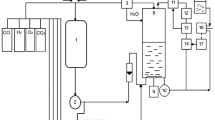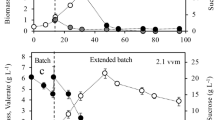Abstract
The behaviour of Halomonas boliviensis during growth in fed-batch culture under different kind of nutrient restrictions was examined. The metabolic switch between growth and accumulation phase is determined by the limitation in one or more essential nutrient for bacterial growth. The aim of this study was to test the effect of applying limitations of a essential nutrient, such as nitrogen, and the influence of different O2 concentrations on poly(3-hydroxybutyrate) (PHB) production during the accumulation phase. Single limitations of nitrogen and oxygen provoke PHB accumulations of 45 and 37 % (g g−1), respectively, while N limitation with low O2 supply causes the highest PHB accumulation of 73 %. The characterization of the PHB production with the strain H. boliviensis would allow a better optimization of the process and enrich the knowledge about the PHB production from strains different than Cupriavidus necator.





Similar content being viewed by others
References
Herbert D (1961) The chemical composition of microorganisms as a function of their growth environment. In: Meynell CG, Gooder H (ed) Microbial reaction to the environment, Cambridge University Press, Cambridge, p 391–416
Kim BS, Lee SC, Lee SY, Chang HN, Chang YK, Woo SI (1994) Production of poly(3-hydroxybutyric acid) by fed-batch culture of Alcaligenes eutrophus with glucose concentration control. Biotechnol Bioeng 43:892–898
Ryu HW, Hahn SK, Chang YK, Chang HN (1997) Production of poly(3-hydroxybutyrate) by high cell density fed-batch culture of Alcaligenes eutrophus with phosphate limitation. Biotechnol Bioeng 55:28–32
Witholt B, Lageveen RG (1992) Process for producing polyesters by fermentation; a process for producing optically active carboxylic acids and esters. US Patent No. 5,135,859. Washington, DC: US Patent and Trademark Office
Ward AC, Rowley BI, Dawes EA (1977) Effect of oxygen and nitrogen limitation on poly-β-hydroxybutyrate biosynthesis in ammonium-grown Azotobacter beijerinckii. J Gen Microbiol 102:61–68
Nath A, Dixit M, Bandiya A, Chavda S, Desai AJ (2008) Enhanced PHB production and scale up studies using cheese whey in fed batch culture of Methylobacterium sp. ZP24. Bioresour Technol 99:5749–5755
Lopar M, Spoljaric IV, Atlic A, Koller M, Braunegg G, Horvat P (2013) Five-step continuous production of PHB analyzed by elementary flux, modes, yield space analysis and high structured metabolic model. Biochem Eng J 79:57–70
Quillaguamán J, Hashim S, Bento F, Mattiasson B, Hatti-Kaul R (2005) Poly(β-hydroxybutyrate) production by a moderate halophile, Halomonas boliviensis LC1 using starch hydrolysate as substrate. J Appl Microbiol 99:151–157
Quillaguamán J, Hatti-Kaul R, Mattiasson B, Alvarez MT, Delgado O (2004) Halomonas boliviensis sp. nov., an alkalitolerant, moderate halophile isolated from soil around a Bolivian hypersaline lake. Int J Syst Evol Microbiol 54:721–725
Yin J, Chen J-C, Wu Q, Chen G-Q (2014) Halophiles, coming stars for industrial biotechnology. Biotechnol Adv. doi:10.1016/j.biotechadv.2014.10.008
Tan D, Xue YS, Aibaidula G, Chen GQ (2011) Unsterile and continuous production of polyhydroxybutyrate by Halomonas TD01. Bioresour Technol 102:8130–8136
Quillaguamán J, Guzmán H, Van-Thuoc D, Hatti-Kaul R (2010) Synthesis and production of polyhydroxyalkanoates by halophiles: current potential and future prospects. Appl Microbiol Biotechnol 85:1687–1696
Kessler B, Witholt B (2001) Factors involved in the regulatory network of polyhydroxyalkanoate metabolism. J Biotechnol 86:97–104
Haywood GW, Anderson AJ, Chu L, Dawes EA (1988) The role of NADH- and NADHP-linked acetoacetyl-CoA reductases in the poly-3-hydroxybutyrate synthesizing organism Alcaligenes eutrophus. FEMS Microbiol Lett 52:259–264
Lee IY, Kim MK, Chang HN, Park YH (1995) Regulation of poly-beta-hydroxybutyrate biosynthesis by nicotinamide nucleotide in Alcaligenes eutrophus. FEMS Microbiol Lett 131:35–39
Liu Y-S, Wu J-Y, Ho K-P (2006) Characterization of oxygen transfer conditions and their effects on Phaffia rhodozyma growth and carotenoid production in shake-flask cultures. Biochem Eng J 27:331–335
van’t Riet K (1979) Review of measuring methods and results in nonviscous gas-liquid mass transfer in stirred vessels. Ind Eng Chem Proc DD 18(3):357–364
APHA (1999) Standard methods for the examination of water and wastewater. American Public Health Association, Washington, DC
Van-Thuoc D, Guzmán H, Quillaguamán J, Hatti-Kaul R (2010) High productivity of ectoines by Halomonas boliviensis using a combined two-step fed-batch culture and milking process. J Biotechnol 147:46–51
Altschul SF, Madden TL, Schäffer AA, Zhang J, Zhang Z, Miller W, Lipman DJ (1997) Gapped BLAST and PSI-BLAST: a new generation of protein database search programs. Nucleic Acids Res 25:3389–3402
Altschul SF, Wootton JC, Gertz EM, Agarwala R, Morgulis A, Schäffer AA, Yu YK (2005) Protein database searches using compositionally adjusted substitution matrices. FEBS J 272:5101–5109
R Core Team (2015) R: A language and environment for statistical computing. R Foundation for Statistical Computing, Vienna, Austria. http://www.R-project.org/. Accessed 12 Dec 2015
Jaki T, Wolfsegger MJ (2011) Estimation of pharmacokinetic parameters with the R package PK. Pharm Stat 10:284–288
González-Peñas H, Lu-Chau TA, Moreira MT, Lema JM (2015) Assessment of morphological changes of Clostridium acetobutylicum by flow cytometry during acetone/butanol/ethanol extractive fermentation. Biotechnol Lett 37:577–584
Liccioli T, Chambers PJ, Jiranek V (2011) A novel methodology independent of fermentation rate for assessment of the fructophilic character of wine yeast strains. J Ind Microbiol Biotechnol 38:833–843
Schubert P, Steinbüchel A, Schlegel HG (1988) Cloning of the Alcaligenes eutrophus gene for synthesis of poly-β-hydroxybutyric acid and synthesis of PHB in Escherichia coli. J Bacteriol 170:5837–5847
Slater S, Houmiel KL, Tran M, Mitsky TA, Taylor NB, Padgette SR, Gruys KJ (1998) Multiple β-ketothiolases mediate poly(β-hydroxyalkanoate) copolymer synthesis in Ralstonia eutropha. J Bacteriol 180:1979–1987
Peoples OP, Sinskey AJ (1989) Poly-β-hydroxybutyrate (PHB) biosynthesis in Alcaligenes eutrophus H16. Identification and characterization of the PHB polymerase gene (phbC). J Biol Chem 264:15298–15303
Haywood GW, Anderson AJ, Dawes EA (1989) The importance of PHB synthase substrate specificity in polyhydroxyalkanoate synthesis by Alcaligenes eutrophus. FEMS Microbiol Lett 57:1–6
Oeding V, Schlegel HG (1973) Beta-ketothiolase from Hydrogenomonas eutropha H16 and its significance in the regulation of poly-beta-hydroxybutyrate metabolism. Biochem J 134:239–248
Quillaguamán J, Van-Thuoc D, Guzmán H, Guzmán D, Martín J, Everest A, Hatti-Kaul R (2008) Poly(3-hydroxybutyrate) production by Halomonas boliviensis in fed-batch culture. Appl Microbiol Biotechnol 78:227–232
Du G-C, Chen J, Gao H-J, Chen Y-G, Lun S-Y (2000) Effects of environmental conditions on cell growth and poly-beta-hydroxybutyrate accumulation in Alcaligenes eutrophus. World J Microbiol Biotechnol 16:9–13
Jackson FA, Dawes EA (1976) Regulation of the tricarboxylic acid cycle and poly-β-hydroxybutyrate metabolism in Azotobacter beijerinckii grown under nitrogen or oxygen limitation. J Gen Microbiol 97:303–312
Kim GJ, Lee IY, Yoon SC, Shin YC, Park YH (1997) Enhanced yield and a high production of medium-chain-length poly(3-hydroxyalkanoates) in a two-step fed-batch cultivation of Pseudomonas putida by combined use of glucose and octanoate. Enzyme Microb Tech 20:500–505
Borah B, Thakur PS, Nigam JN (2002) The influence of nutritional and environmental conditions on the accumulation of poly-β-hydroxybutyrate in Bacillus mycoides RLJ B-017. J Appl Microbiol 92:776–783
Kshirsagar P, Suttar R, Nilegaonkar S, Kulkarni S, Kanekar P (2012) Scale up production of polyhydroxyalkanoate (PHA) at different aeration, agitation and controlled dissolved oxygen levels in fermenter using Halomonas campisalis MCM B-1027. J Biochem Tech 4:512–517
Acknowledgments
The authors belong to the Galician Competitive Research Group GRC 2013-032 (program co-funded by FEDER) and to the strategic group CRETUS (AGRUP2015/02).
Author information
Authors and Affiliations
Corresponding author
Ethics declarations
Conflict of interest
No conflict of interest declared.
Rights and permissions
About this article
Cite this article
García-Torreiro, M., Lu-Chau, T.A. & Lema, J.M. Effect of nitrogen and/or oxygen concentration on poly(3-hydroxybutyrate) accumulation by Halomonas boliviensis . Bioprocess Biosyst Eng 39, 1365–1374 (2016). https://doi.org/10.1007/s00449-016-1612-y
Received:
Accepted:
Published:
Issue Date:
DOI: https://doi.org/10.1007/s00449-016-1612-y




